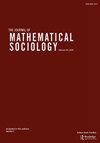A dynamical systems model of unorganized segregation in two neighborhoods
IF 1.3
4区 社会学
Q3 MATHEMATICS, INTERDISCIPLINARY APPLICATIONS
引用次数: 1
Abstract
ABSTRACT We present a complete analysis of the Schelling dynamical system of two connected neighborhoods, with or without population reservoirs, for different types of linear and nonlinear tolerance schedules. We show that stable integration is only possible when the minority is small and combined tolerance is large. Unlike the case of the single neighborhood, limiting one population does not necessarily produce stable integration and may destroy it. We conclude that a growing minority can only remain integrated if the majority increases its own tolerance. Our results show that an integrated single neighborhood may not remain so when a connecting neighborhood is created.两个社区无组织隔离的动态系统模型
摘要对于不同类型的线性和非线性容差调度,我们对具有或不具有种群库的两个连通邻域的Schelling动力系统进行了完整的分析。我们证明,只有当少数人很小,综合容忍度很大时,稳定的整合才有可能。与单一社区的情况不同,限制一个人口并不一定会产生稳定的融合,而且可能会破坏它。我们得出的结论是,只有大多数人增加自己的容忍度,不断增长的少数人才能保持融合。我们的结果表明,当创建连接邻域时,集成的单个邻域可能不会保持不变。
本文章由计算机程序翻译,如有差异,请以英文原文为准。
求助全文
约1分钟内获得全文
求助全文
来源期刊

Journal of Mathematical Sociology
数学-数学跨学科应用
CiteScore
2.90
自引率
10.00%
发文量
5
审稿时长
>12 weeks
期刊介绍:
The goal of the Journal of Mathematical Sociology is to publish models and mathematical techniques that would likely be useful to professional sociologists. The Journal also welcomes papers of mutual interest to social scientists and other social and behavioral scientists, as well as papers by non-social scientists that may encourage fruitful connections between sociology and other disciplines. Reviews of new or developing areas of mathematics and mathematical modeling that may have significant applications in sociology will also be considered.
The Journal of Mathematical Sociology is published in association with the International Network for Social Network Analysis, the Japanese Association for Mathematical Sociology, the Mathematical Sociology Section of the American Sociological Association, and the Methodology Section of the American Sociological Association.
 求助内容:
求助内容: 应助结果提醒方式:
应助结果提醒方式:


